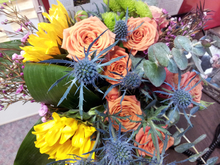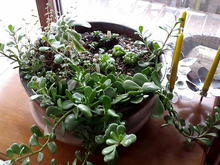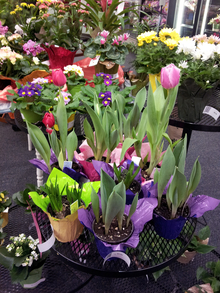We haven’t had much opportunity lately to actually be with people we love, except online. February 14 celebrates L-O-V-E as well as great friendships and relationships that simply make our lives better.
Choosing a flowering indoor plant or cut flowers is a great way to tell people how much they mean to you on Valentine's Day.
Roses and cut flowers
A bouquet of cut flowers is perfect for that special someone who doesn’t want the responsibility of caring for a plant. Maybe their home doesn’t offer enough light or space for a live plant, or they simply don’t want a plant they have to tend.
Cut flowers should be fresh, brightly colored, have firm stems, and include some buds for future flowers. Here’s a helpful video on cut flower care from professor emeritus Mary Meyer.
Orchids
Orchids have become more readily available and more affordable thanks to progress in tissue culture propagation. The moth orchid (Phalaenopsis) is one of the most forgiving and easiest to grow orchids for the typical homeowner.
Orchids like bright light and cool temperatures (around 70-75 F during the day, 60-65 F at night).
Native to southeast Asia, the Philippines and Australia, the moth orchid is an epiphyte and grows in trees in the wild, drawing nutrients from the tree and moisture from rain and the air. Moth orchids care from Orchids Ltd.
Cyclamen
The delicate Cyclamen is available in various sizes from gloriously large plants to cute little miniature plants, and with petals that range from white to red to pink to purple and smooth, fringes, folded.
Wild cyclamen grow in the Mediterranean while the plants we buy as houseplants are hybrids of the native species.
Cyclamen grow well in cool temperatures (50-60 F) and bright, indirect light. They are actually a bulb, so avoid watering the crown of the plant (where stems emerge) and allow the plant to drain well. Find more on Cyclamens from the Chicago Botanic Garden.
Cacti and succulents
Cacti may not be massive bloomers, but they are unique and thoughtful plants to give. Best tip: while they need bright light, they are drought tolerant and low nutrient plants. Native to the Americas, cacti are slow-growing and rarely require repotting.
Succulents are the rockstars of indoor plants these days. Their unique forms, relatively slow growth and low care needs make them great options for people in a wide variety of living environments. If one succulent isn’t enough, consider a succulent dish garden in a shallow container with good drainage, cactus soil and a variety of succulents. More information on cacti and succulents from Extension.
African violets
African violets (Saintpaulia) are cute, round plants with fuzzy leaves and tiny flowers that range from white to magnets to blue and white to deep purple. They are native to eastern Africa where they grow out of mossy rock crevices in temperatures that vary from 65 to 85 F.
While they prefer humidity, do not overwater them. In fact, under watering is better. Overwatering and poor drainage are the most common reasons African violet plants fail. Find more information on African violets from Extension.
Bulb gardens
Bulb gardens deliver on blooms! A harbinger of warmer days to come, bulb gardens are fun whether your valentine is 9 or 90. Grown in a sunny window, it’s great to watch the tulips, daffodils, hyacinth, crocus and muscari emerge and show off their flowers of purple, blue, white, yellow, and pink.
These bulbs are “forced”, which means they have been subjected to cold temperatures that activate plant hormones to start budding and bloom. Many of the bulbs are cold-hardy here in Minnesota, but forced bulbs use up all their energy to bloom indoors and they won’t reliably rebloom if planted outdoors.
Bulb gardens are readily available at garden centers, or you can grow your own. Tip: Plan ahead — forcing bulbs requires 8-12 weeks in a dark cool environment. Find out more about growing bulbs indoors.
Gardenias
Their waxy, creamy white flowers have a heady fragrance that makes you think of a tropical vacation. But the Gardenia jasminoides can be a challenge even for the most seasoned plant grower.
Native to Asia, gardenias grow in high humidity, cool temperatures, bright light and need consistent nutrients and water. Our dry home environments that often lack light can cause a new gardenia plant to drop buds and cause leaves to turn yellow, and they can be susceptible to insect pests.
The best approach is to mimic the gardenia’s native environment: provide bright light - even supplement natural light with artificial light - and cool temperatures (around 65 F by day, 55 F by night). Even watering and diluted amounts of fertilizer will help keep your gardenia healthy. More information on growing gardenias from Purdue University Extension.




